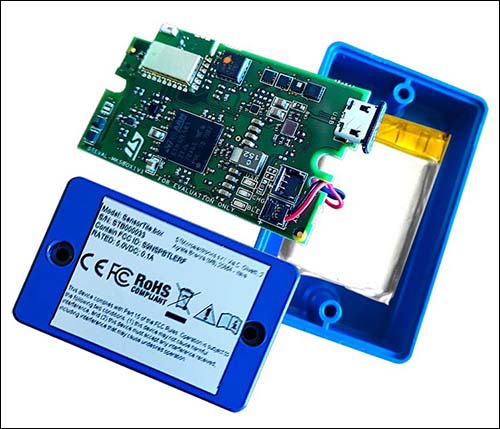Striving to bring Internet of Things (IoT) technology to those with the least technical background, STMicroelectronics has released a low-cost, plug-and-play IoT node with sensors, bundled with an app, to enable anyone with a smartphone to start testing an IoT solution. The company’s STEVAL-MKSBOX1V1 (SensorTile.box) system is designed to be a tool for affordable experimenting, at a price under $45. The solution is aimed not only at entry-level users with no programming skills, but also at academic researchers, systems integrators and cloud developers.
The development aims to address a new audience for IoT technology: those with no technical background. “We have identified certain needs in the market, and that’s why last year we decided to develop this kit,” says Edoardo Gallizio, STMicroelectronics’ product marketing manager. One of these requirements, he says, is for people who are not experts but have good ideas and use cases to be able to experiment with a previously unfamiliar technology.
With that in mind, the company explains, the SensorTile.box is designed to be easily configured to start collecting data from sensors, while it is also intended to serve mid-level developers in what STMicroelectronics calls “exploration mode,” such as college researchers, experienced engineers or large firms looking to build their own solutions. With the SensorTile.box, the company aims to expand its customer base by providing tools for non-experts to become experts. IoT technology can provide an “interface between our world and the device world,” Gallizio says, adding, “We really believe one of the advantages of technology is that it is becoming easier and easier for people to accomplish that.”
The node includes accelerometers, as well as temperature, inertial measurement, magnetometer, pressure and humidity sensors, and a microphone for audio sensing. It is already being used to track data regarding individuals and livestock, the company indicates, and for predictive maintenance for equipment. Use cases include a simple pedometer to track movement, the detection of crying babies, environmental monitoring and goods tracking, and as an inclinometer and sensor data logger. For instance, the microphone can be used to detect voice or sound, while the pressure sensor can approximate altitude (such as the floor on which the device is located). Vibration can be tracked via the accelerometer for a variety of purposes, including identifying potential earthquakes.
In one case, the SensorTile.box is on its way to the highest point on Earth, stored in the pocket of Italian Mount Everest climber Luca Colli. The node is helping him to measure his movements and conditions in the mountain’s extreme conditions, including air pressure, temperature, oxygen density and activity. Once he completes his climb, the module will be returned to Italy for analysis. The device’s onboard EM32 processor captures the sensor data and uses Bluetooth Low Energy (BLE) to transmit information to a user’s phone, where the Android- or iOS-based app can capture and provide condition-based data.
The node has a built-in battery that can be recharged via a USB cord. It can be set to developer mode, allowing users to activate or shut down individual sensors in order to optimize their power consumption, as well as to combine data from multiple sensors to improve overall data accuracy. Users also can calibrate individual sensors. Additionally, the node employs an LSM6DSOX machine-learning core and artificial-intelligence (AI) extensions for use by more advanced individuals, enabling a system with pattern recognition, for use in tracking activity or environments based on multiple sensor measurements.
Data can be collected on an SD card if a user does not want to stream sensor data to the app. In that way, Gallizio says, “People can open the box and slide in an SD card to do data logging, without a BLE link,” in remote locations where an Android or iOS device would not be available to capture data in real time.
STMicroelectronics expects the kit to be used by both private individuals and businesses. For instance, Gallizio says, a manufacturer may lack a budget for a large wireless solution, or it might not be ready to commit funds to a system that hasn’t been tested, but it may want to capture predictive maintenance data for its equipment.
By buying multiple SensorTile.box devices, Gallizio says, a company could capture data across its facility at a relatively low cost. And by testing the solution with the sensors, he explains, “The time to market becomes much faster.” He adds, “We’ve got examples of new customers who are shortening the development phase from several months to weeks. You can significantly shorten the phase from idea to proof-of-concept.”
This is not the company’s first kit. Several years ago, the firm released previous versions of its SensorTile aimed at developers and experts. It required, for instance, that users solder to the device the sensors they intended to use—something an amateur is not likely to do on his or her own. The newer version includes more sensors than its predecessor. STMicroelectronics’ goal is to get IoT technology in the hands of the public so it can begin to build a new, wider customer base. “We want to bring the technology into as many hands as possible,” Gallizio states.
The SensorTile.box leverages Microsoft‘s Azure IoT Central platform to simplify the connection of sensor data to the cloud for analysis. The SensorTile.box measures 57 millimeters by 38 millimeters by 20 millimeters (2.2 inches by 1.5 inches by 0.8 inch) in an IP54 plastic container, and is available at STMicroelectronics’ website or through its distributors.
Professional users can develop powerful applications quickly and efficiently within the STM32 Open Development Environment (STM32 ODE), leveraging the company’s STM32CubeMX configurator and code generator, as well as its STLink-V3 programmer and debugger. “We think this is one of the biggest announcements in the IoT world right now,” Gallizio says. By the end of the year, he notes, STMicroelectronics plans to offer a full software developers kit (SDK) for advanced IoT development.



